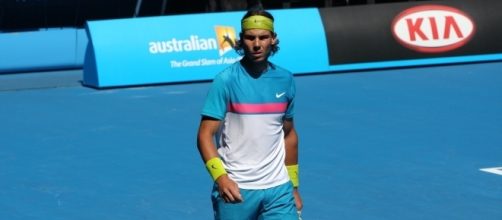Rafael Nadal’s game is dependent on his heavy top spin forehand, and the capacity of his legs to run for hours so he can retrieve every ball. His forehand is fueled by the speed in his legs; while his top spin heavy shots provide his legs the time required to reach and return the next ball, and together they have helped him dominate the French Open.His heavy top spin forehand and his retrieving abilities have helped him dominate the Clay Courts.
Is Rafael Nadal's game too reliant on his top spin?
The heavy top spin generated by him on his forehand forces the opponent to wait for the right moment to strike the ball thereby allowing Rafel Nadal enough time to recover to the center and be in the position to return the next shot.
Nadal’s heavy top-spun forehand, therefore, supports his retrieving abilities and, I suspect, was developed with clay courts on Uncle Toni’s, mind. The excessive top spin not only makes the ball jump higher but also renders it heavier and, thereby, pushier on the clay courts.
The granular nature of clay increases not only the spin but also heaviness of the ball. Moreover, it is a little easier to hit a spinning ball with top spin rather than flat, and a top-spun ball back from the opponent also adds to the time that Nadal gets to position himself for his shot. Therefore, Nadal's heavy top spin allows him the time to reach the balls early enough to execute his shots on the clay courts.
Nadal's top spin loses its advantage on the grass and hard courts.
The same heavy top spin, apparently, is not so effective on hard courts and especially on grass. Indoor courts do not assist the spin of the ball as much and therefore the ball does not rise or push the opponent as much. When Rafael Nadal attempts to flatten his shots on hard or grass courts, the ball returns to him much faster than on clay; as all the opponent has to do is use Nadal’s speed, and reduced spin, to block or hit it with a shortened back-swing and send it back faster.
Three years ago Nadal was a little quicker and could reach these balls. However, nowadays his legs are not as fast as they once were, and he needs the extra time that the clay courts give him.
Nadal is quite good at volleying too and, unlike Djokovic, he approaches the net correctly but chooses to stay five feet behind the base line to grind it out, and that to me is a classic clay court player equipped with the modern day’s string technology.
In essence, Nadal’s game is tailor-made for the clay courts and the fact that he won five of his fifteen slams on hard and grass courts is a testament to his on-court speed, insuperable stamina, and mental strength.
It is quite obvious that Nadal's playing style and ground shots are both designed for the clay courts.


